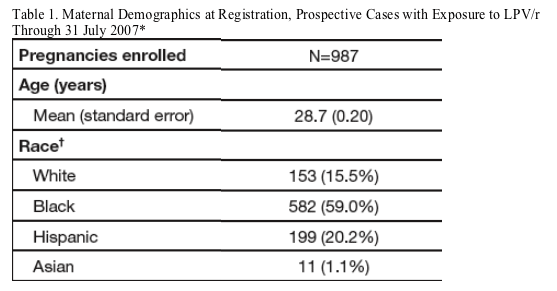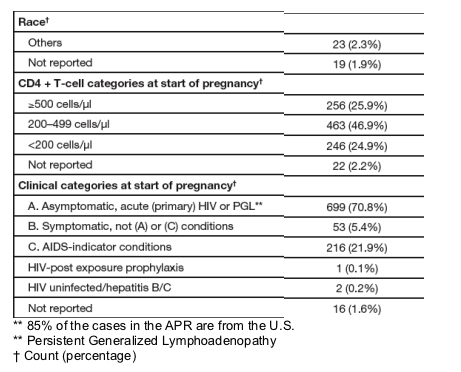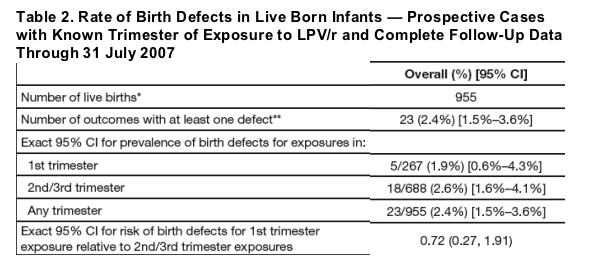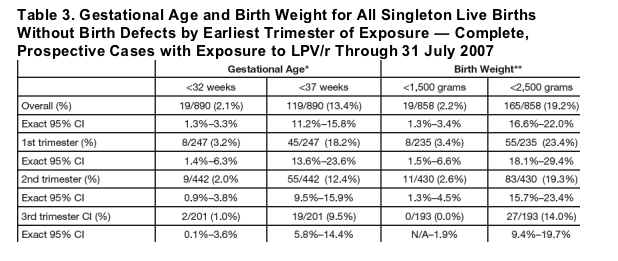 |
 |
 |
| |
Lopinavir/ritonavir (LPV/r) in Pregnancy: ART Pregnancy Registry
|
| |
| |
Reported by Jules Levin
IAC Aug 3-8, 2008 Mexico City
Susan S. Roberts, PhD1, Marisol Martinez, MD2, Deborah L. Covington, DrPH3, Mary V. Pasley, RNC-NP2, and William Woodward, DO2. 1University of North Carolina Wilmington; 2Abbott Laboratories; 3Kendle International Inc.
Background
The Antiretroviral Pregnancy Registry (APR) is an international, prospective, exposure-registration study established in 1989 to collect data on birth outcomes, primarily birth defects, following pregnancy exposures to antiretroviral therapy.
LPV/r joined the Registry in 2000 upon US FDA approval. LPV/r is widely used in the HIV-infected population and is the only PI currently recommended by the DHHS (Department of Health and Human Services) for the use during pregnancy.1
OBJECTIVE
This study examines birth defects following pregnancy exposures to LPV/r.
METHODOLOGY
The analysis population includes all prospective LPV/r-exposed pregnancies enrolled in the APR, with or without concurrent exposure reported to other antiretroviral therapy, from January 2000 through July 2007.
Prevalence of birth defects following pregnancy exposure to LPV/r was compared to prevalence observed in the CDC's Metropolitan Atlanta Congenital Defects Program (MACDP)2 population-based surveillance system.
Additionally, first trimester exposures (when organogenesis occurs) were compared with combined second/third trimester exposures.
Based on sample size calculation a cohort of 267 live born infants with first trimester exposure to LPV/r is sufficient to detect a 2.4-fold increase in the risk of birth defects (i.e., for all defects combined) compared to the CDC's (MACDP) expected prevalence.2
-- This sample size assumes 80% power and a two-tailed Type 1 error rate of 5%.
For individual birth defects, sample size requirements are greater; the power to detect an increased risk in a specific defect varies and depends upon the frequency of the defect in the population and the size of the LPV/r-exposed group.
RESULTS
The analysis population includes all complete data on exposure and birth outcomes on pregnancies enrolled in the APR and exposed to LPV/r during the period from September 2000 through July 2007.
The APR received 7255 complete prospective reports of pregnancy exposures to one or more antiretroviral drugs; of these, 1051 were LPV/r exposures. Among the 1051 LPV/r exposures, 987 (93.9%) were reports of exposures to LPV/r with complete follow up and an additional 64 (6%) lost to follow up (Table 1).
Of the 987 LPV/r exposures with complete follow-up, there were 1006 pregnancy outcomes. Of the 987, one case had no data on trimester of exposure and was excluded from birth defect rate analysis.
968/986 (98.2%) were singleton outcomes of which 920 were live births, 39 spontaneous losses or induced abortions and 9 stillbirths.
Multiple pregnancies represented 1.8% of all pregnancies resulting in 35 live births and 2 stillbirths.
Birth defects were reported in 22 of the 955 live births and 1 out of the 11 stillbirths. The rate of birth defects in live born infants is summarized in Table 2.


Among 267 live births with first trimester exposures, 5 were cases with birth defects (1.9%, 95% CI = 0.6, 4.3).
These rates are similar to the CDC's MACDP birth defect surveillance system rate (2.67%) and the birth defect rate among infants with 2nd/3rd trimester LPV/r exposures (2.6, 95% CI = 1.6, 4.1; risk ratio = 0.7, 95% CI = 0.3, 1.9).
No pattern of birth defects suggestive of a common etiology was seen.

** Excludes 1 singleton live birth with no defects due to unspecified trimester of exposure. Includes 920 singleton and 35 multiple live birth outcomes.
** Defects meeting the CDC criteria only. Excludes reported defects in pregnancy losses <20 weeks. An outcome is defined as a live or stillborn infant, or a spontaneous or induced pregnancy loss ≥20 weeks gestation.
Among singleton births, 13.4% occurred prior to 37 weeks of gestation, and 19.2% were less than 2,500 grams at birth (Table 3).
Infants whose earliest exposure to LPV/r occurred in the first trimester appeared more likely to be born prior to 37 weeks of gestation than those whose first exposure was later. These infants also appeared more likely to have low birth weight compared to those whose earliest exposure occurred in the second or third trimester.

* Excludes 1 singleton live birth due to unspecified trimester of exposure and 9 cases with missing gestational age.
** Excludes 1 singleton live birth due to unspecified trimester of exposure, 37 cases with missing birth weights and 4 with missing birth weight and gestational age.
Note: Only upper confidence limits are presented when no events were observed.
DISCUSSION
The APR previously reported an overall prevalence of birth defects of 2.7% ARV exposed pregnancies and 2.8% among first trimester exposures.3 Other large observational studies have reported similar findings.4-6
The overall prevalence of birth defects in LPV/r exposed pregnancies was 2.4%. The prevalence of birth defects following first trimester LPV/r exposures was 1.9%. These rates are similar to the prevalence rates in the reference group, the CDC's MACDP: 2.67% overall and 2.09% in the early diagnosis rate.
-- Data from this study were provided primarily by obstetricians who often have limited access to diagnoses made after the first few days of life, possibly making these early diagnosis rates a more appropriate comparator.
Prevalence of birth defects following first trimester exposure was 1.9%, whereas the rate following second and third trimester exposures was 2.6%.
In this study, the overall prematurity rate of LPV/r was 13.4% comparable to previously published data on preterm rates of infants exposed to protease inhibitors in utero that varies from 18% to 36%.7-9
While these results may be informative, it is important to note that the primary objective of this analysis was to examine birth defects. Data collected on gestational age and birth weight were secondary.
A limitation of this analysis is data on mother's smoking history, anemia during pregnancy or cesarean sections were not collected, all factors associated with a higher risk of prematurity.
CONCLUSIONS
This is the first adequately powered and published analysis on the risk of birth defects associated with LPV/r exposures during pregnancy.
This study suggests the overall prevalence of birth defects among infants prenatally exposed to LPV/r is not statistically significantly different from comparison groups.
While the registry population exposed and monitored to date is not sufficient to detect an increase in risk of relatively rare birth defects, these results provide patients and prescribers with information to weigh risks and benefits needed to provide some assurance when counseling patients.
REFERENCES
1. Recommended Antiretroviral Agents for Perinatal Use: PHS Task Force November 2007. Available at:
http://www.aidsinfo.nih.gov/ContentFiles/AdultandAdolescentGL.pdf. Revision January 29, 2008.
2. Centers for Disease Control and Prevention. Metropolitan Atlanta Congenital Defects Program. Surveillance procedure manual and guide to computerized anomaly record. Atlanta (GA): US Department of Health and Human Services, Public Health Service 1998.
3. Antiretroviral Pregnancy Registry Steering Committee. Antiretroviral Pregnancy Registry International Interim Report for 1 January 1989 through 31 July 2007. Wilmington, NC: Registry Coordinating Center; 2007.
4. European Collaborative Study: Exposure to antiretroviral therapy in utero or early life: The health of uninfected children born to HIV-1 infected women. JAIDS. 2003;32:380–7.
5. Townsend CL, Tookey PA, Cortina-Borja M, Peckham CS. Antiretroviral therapy and congenital abnormalities in infants born to HIV-1 infected women in the United Kingdom and Ireland, 1990–2003. JAIDS. 2006;42(1)91–4.
6. Watts DH, Danner L, Handelsman E, Tilson H, Paul M, et al. Assessment of Birth Defects According to Maternal Therapy Among Infants in the Women and Infants Transmission Study. JAIDS. 2007;44:299–305.
7. Morris AB, Dobles AR, Cu-Vin S, Zorrilla C, Anderson J, Harwell J, et al. Protease inhibitor use in 233 pregnancies. JAIDS. 2005;4a0:30–33.
8. Schullte J, Dominguez K, Sukalac T, Bohannon B, Fowler M. Pediatric Spectrum of HIV Disease Consortium. Declines in low birth weight and preterm birth among infants who were born to HIV–infected women during an
era of increased use of maternal antiretroviral drugs: pediatric spectrum of HIV disease, 1989–2004. Pediatrics. 2007;119:e900–6.
9. Townsend CL, Cortina-Borja M, Peckman CS, Tookey PA. Antiretroviral therapy and premature delivery in diagnosed HIV-infected women in the United Kingdom and Ireland. AIDS. 2007;21:1019–26.
|
| |
|
 |
 |
|
|